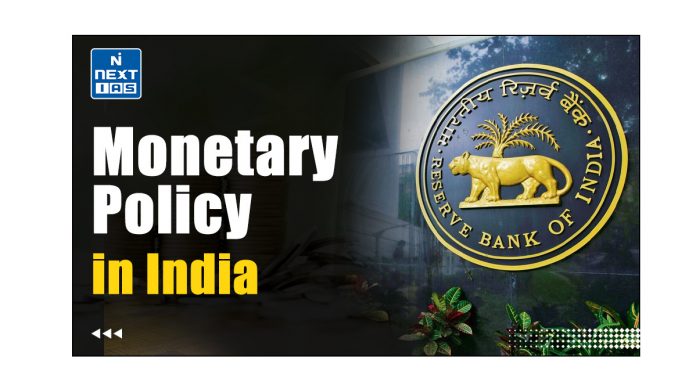

Monetary Policy in India is the lifeblood of India’s economy. As a critical economic management tool, it helps the RBI and the Government to control the supply of money, manage inflation, and achieve economic stability. This article of NEXT IAS aims to study in detail the Monetary Policy in India, its meaning, types, the process of formulation, major tools used therein, and other related concepts.
It is a macroeconomic policy tool used by the Central Bank to influence the money supply in the economy to achieve certain macroeconomic goals. It involves the use of monetary instruments by the central bank to regulate the availability of credit in the market to achieve the ultimate objective of economic policy.
Some of its major objectives are as follows:
The two policies differ in various respects as can be seen below.
| Fiscal Policy | Monetary Policy | |
|---|---|---|
| Definition | It is a macro-economic policy used by the government to adjust its spending levels and tax rates to monitor a nation’s economy | It is a macroeconomic policy used by the Central Bank to influence money supply and interest rates. |
| Institutional Control | Controlled by the Government | Controlled by the Central Bank |
| Prime Objective | To influence the economic condition | To influence the money supply and interest rates. |
| Major Tools | Public Expenditure, Taxation, Public Borrowing etc | Bank Rate, Cash Reserve Ratio, Statutory Liquidity Ratio etc |

Broadly, there are two types of monetary policy – Expansionary Monetary Policy, and Contractionary Monetary Policy.
In India, the Reserve Bank of India Act of 1934 explicitly mandates the Reserve Bank of India (RBI) with the responsibility of formulating the monetary policy for the country. The process of monetary policy formulation in India underwent a paradigm shift in the year 2016 as explained below.
Prior to the year 2016, the Governor of RBI was singularly responsible for the formulation of monetary policy in India. Although the Governor was advised by a Technical Committee, but he could veto decisions.

Fixed inflation targets restrain the RBI from taking any tight policy stance.
Various instruments used by the RBI to control the money supply can be categorized into two categories:

Major instruments coming in this category are explained below:
The reserve requirement or required reserve ratio is a bank regulation that sets the minimum reserves each bank must hold as a part of the deposits.
It comprises two instruments:
Repo Rate is the rate of interest at which the RBI provides short-term loans to SCBs against approved securities.
Reverse Repo Rate is the rate of interest at which the RBI borrows funds from the SCBs. In other words, it is the rate at which SCBs park their excess funds with the RBI for a short period of time.
MSF represents the upper band of the interest corridor, and Reverse Repo Rate is the lower band. The Repo Rate stands in the middle and acts as an anchor rate.

Major instruments coming in this category are explained below
The RBI takes direct action such as refusing to rediscount the bills or charging penal interest rates, etc when a commercial bank does not co-operate with the central bank in achieving its desirable objectives.
Under this, the RBI fixes a ceiling on the amount of loans that can be granted by SCBs. As a result, SCBs tighten in advancing loans to the public.
Under this, the RBI prescribes the banks to provide a specified portion of the bank lending to a few specific sectors like agriculture and allied activities, micro and small enterprises, poor people for housing, etc.



It refers to the process by which the RBI takes away money from the banking system to neutralize the fresh money that enters the system.
Under Strict Inflation Targeting, the central bank is only concerned about keeping inflation as close to a given inflation target as possible, and nothing else.
Under Flexible Inflation Targeting, apart from keeping inflation within the target range, the central bank is also concerned about other things, such as the stability of interest rates, exchange rates, output, and employment.
Monetary Policy in India plays a pivotal role in stabilizing the economy and fostering a conducive environment for sustainable growth. The dynamic nature of the global economy, internal structural constraints, and the complex interplay between fiscal and monetary policies mean that constant vigilance and adaptability are required to navigate the path ahead. As India continues to develop and integrate further into the global economy, the formulation and implementation of monetary policy will remain a key area of focus for policymakers.
The RBI Act of 1934 explicitly mandates the Reserve Bank of India (RBI) with the responsibility of controlling the monetary policy for the country.
At present, monetary policy in India is formulated by the Monetary Policy Committee (MPC), which was set up by an amendment in the RBI Act of 1934 through the Finance Act of 2016.
Its most important function is to control the supply of money in the market. Along with this, it also ensures the growth of the economy and price stability.
It is an agreement signed between the RBI and the Center in 2015, the primary objective of which is to ensure price stability while accelerating economic growth.